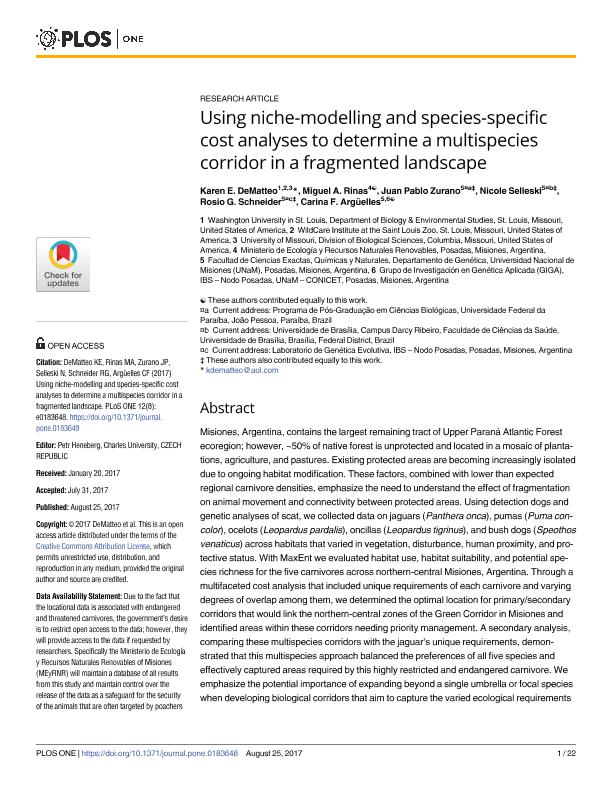Artículo
Using niche-modelling and species-specific cost analyses to determine a multispecies corridor in a fragmented landscape
Dematteo, Karen; Rinas, Miguel A.; Zurano, Juan Pablo; Selleski, Nicole; Schneider, Rosio Gabriela ; Argüelles, Carina Francisca
; Argüelles, Carina Francisca
 ; Argüelles, Carina Francisca
; Argüelles, Carina Francisca
Fecha de publicación:
08/2017
Editorial:
Public Library of Science
Revista:
Plos One
e-ISSN:
1932-6203
Idioma:
Inglés
Tipo de recurso:
Artículo publicado
Clasificación temática:
Resumen
Misiones, Argentina, contains the largest remaining tract of Upper Paraná Atlantic Forest ecoregion; however, ~50% of native forest is unprotected and located in a mosaic of plantations, agriculture, and pastures. Existing protected areas are becoming increasingly isolated due to ongoing habitat modification. These factors, combined with lower than expected regional carnivore densities, emphasize the need to understand the effect of fragmentation on animal movement and connectivity between protected areas. Using detection dogs and genetic analyses of scat, we collected data on jaguars (Panthera onca), pumas (Puma concolor), ocelots (Leopardus pardalis), oncillas (Leopardus tigrinus), and bush dogs (Speothos venaticus) across habitats that varied in vegetation, disturbance, human proximity, and protective status. With MaxEnt we evaluated habitat use, habitat suitability, and potential species richness for the five carnivores across northern-central Misiones, Argentina. Through a multifaceted cost analysis that included unique requirements of each carnivore and varying degrees of overlap among them, we determined the optimal location for primary/secondary corridors that would link the northern-central zones of the Green Corridor in Misiones and identified areas within these corridors needing priority management. A secondary analysis, comparing these multispecies corridors with the jaguar’s unique requirements, demonstrated that this multispecies approach balanced the preferences of all five species and effectively captured areas required by this highly restricted and endangered carnivore. We emphasize the potential importance of expanding beyond a single umbrella or focal species when developing biological corridors that aim to capture the varied ecological requirements of coexisting species and ecological processes across the landscape. Detection dogs and genetic analyses of scat allow data on multiple species to be collected efficiently across multiple habitat types independent of the degree of legal protection. These data used with multi-focal GIS analyses balance the varying degree of overlap and unique properties among them allowing for comprehensive conservation strategies to be developed relatively rapidly. Our comprehensive approach serves as a model to other regions faced with habitat loss and lack of data. The five carnivores focused on in our study have wide ranges, so the results from this study can be expanded and combined with surrounding countries, with analyses at the species or community level.
Palabras clave:
Carnivores
,
Detection Dogs
,
Niche Modelling
,
Maxent
,
Multispecies Corridor
Archivos asociados
Licencia
Identificadores
Colecciones
Articulos(IBS)
Articulos de INSTITUTO DE BIOLOGIA SUBTROPICAL
Articulos de INSTITUTO DE BIOLOGIA SUBTROPICAL
Citación
Dematteo, Karen; Rinas, Miguel A.; Zurano, Juan Pablo; Selleski, Nicole; Schneider, Rosio Gabriela; et al.; Using niche-modelling and species-specific cost analyses to determine a multispecies corridor in a fragmented landscape; Public Library of Science; Plos One; 12; 8; 8-2017; 1-22; e0183648
Compartir
Altmétricas



